|
|
|
Sort Order |
|
|
|
Items / Page
|
|
|
|
|
|
|
| Srl | Item |
| 1 |
ID:
137030
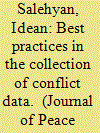

|
|
|
|
|
| Summary/Abstract |
Quality data is at the heart of all empirical research. Data collection on contentious politics, including civil war, terrorism, and protest has proceeded at a rapid pace over the last several years. This special section develops a set of best practices and offers advice to those involved in collecting conflict data as well as those who are regular users of such data. In this introduction, the process of data collection is considered, including source selection, information extraction or ‘coding’, and data sharing. A set of six rules is offered, which will hopefully guide others as they compile quantitative data on conflict processes.
|
|
|
|
|
|
|
|
|
|
|
|
|
|
|
|
| 2 |
ID:
134940


|
|
|
|
|
| Summary/Abstract |
This article reflects on the importance of linking micro and macro levels of analysis in order to advance our current understanding of civil wars and political violence processes and discusses the contributions of the articles in this special issue. We first identify the main problems in research on political violence that is focused on a single level of analysis and describe the challenges faced by research that attempts to establish connections between different levels. We then introduce the different articles in the special issue, with an emphasis on the micro–macro-level linkages they develop and highlighting their commonalities. We conclude by emphasizing the importance of a new research agenda for the study of civil wars and political violence that bridges social, economic, and political dynamics occurring at the local level and conflict processes taking place in the macro arena.
|
|
|
|
|
|
|
|
|
|
|
|
|
|
|
|
| 3 |
ID:
136504


|
|
|
|
|
| Summary/Abstract |
Even as protests spread across the Middle East in early 2011, the regime of Bashar al-Assad in Syria appeared immune from the upheaval. Assad had ruled comfortably for over a decade, having replaced his father, Hafez, who himself had held power for the previous three decades. Many pundits argued that Syria’s sturdy police state, which exercised tight control over the country’s people and economy, would survive the Arab Spring undisturbed. Compared with its neighbor Lebanon, Syria looked positively stable. Civil war had torn through Lebanon throughout much of the 1970s and 1980s, and the assassination of former Prime Minister Rafiq Hariri in 2005 had plunged the country into yet more chaos.
|
|
|
|
|
|
|
|
|
|
|
|
|
|
|
|
| 4 |
ID:
134943


|
|
|
|
|
| Summary/Abstract |
This article examines desertion in civil wars, focusing on the role of combatants’ hometowns in facilitating desertion. Analyzing data from the Spanish Civil War, the article demonstrates that combatants who come from hill country are considerably more likely to desert than combatants whose hometowns are on flat ground. This is because evasion is easier in rough terrain. The finding implies that the cohesion of armed groups depends on control, not just positive incentives, and that control of territory in civil wars goes beyond rebel–government contestation, and consists also of control behind the lines. The article bridges micro and macro approaches to civil wars by indicating the multiple uses to which individuals can put structural conditions like rough terrain. This helps to clarify the macro-level link between rough terrain and civil war. It also shows that micro-level research can profitably examine structural variables alongside individual characteristics and endogenous conflict dynamics.
|
|
|
|
|
|
|
|
|
|
|
|
|
|
|
|
| 5 |
ID:
134942
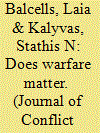

|
|
|
|
|
| Summary/Abstract |
Does it matter whether a civil war is fought as a conventional, irregular, or symmetric nonconventional conflict? Put differently, do “technologies of rebellion” impact a war’s severity, duration, or outcome? Our answer is positive. We find that irregular conflicts last significantly longer than all other types of conflict, while conventional ones tend to be more severe in terms of battlefield lethality. Irregular conflicts generate greater civilian victimization and tend to be won by incumbents, while conventional ones are more likely to end in rebel victories. Substantively, these findings help us make sense of how civil wars are changing: they are becoming shorter, deadlier on the battlefield, and more challenging for existing governments—but also more likely to end with some kind of settlement between governments and armed opposition. Theoretically, our findings support the idea of taking into account technologies of rebellion (capturing characteristics of conflicts that tend to be visible mostly at the micro level) when studying macro-level patterns of conflicts such as the severity, duration, and outcomes of civil wars; they also point to the specific contribution of irregular war to both state building and social change.
|
|
|
|
|
|
|
|
|
|
|
|
|
|
|
|
| 6 |
ID:
134479
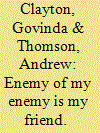

|
|
|
|
|
| Summary/Abstract |
This article assesses the effect that leveraging civilian defense force militias has on the dynamics of violence in civil war. We argue that the delegation of security and combat roles to local civilians shifts the primary targets of insurgent violence toward civilians, in an attempt to deter future defections, and re-establish control over the local population. This argument is assessed through an analysis of the Sunni Awakening and ancillary Sons of Iraq paramilitary program. The results suggest that at least in the Al-Anbar province of Iraq, the utilization of the civilian population in counterinsurgent roles had significant implications for the targets of insurgent violence.
|
|
|
|
|
|
|
|
|
|
|
|
|
|
|
|
| 7 |
ID:
136513
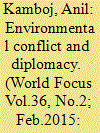

|
|
|
|
|
| Summary/Abstract |
As the global population continues to rise, and the demand for resources continues to grow, there is significant potential for conflicts over natural resources to intensify in the coming decades. At least eighteen violent conflicts have been fuelled by the exploitation of natural resources since 1990. Recent research suggests that over the last sixty years at least forty per cent of all intrastate conflicts have a link to natural resources. Civil wars such as those in Liberia, Angola and the Democratic Republic of Congo have centred on "high-value" resources like timber, diamonds, GOLD, minerals and oil. Some conflicts have involved to control scarce resources such as fertile land and water.
|
|
|
|
|
|
|
|
|
|
|
|
|
|
|
|
| 8 |
ID:
136094


|
|
|
|
|
| Summary/Abstract |
A large literature demonstrates that civil war is recurrent: States that have already experienced such conflict tend to relapse back into war. How might this ‘conflict trap’ be escaped? We answer this question with a focus on gender. Women tend to exist at the margins of society, and postwar society often perpetuates prewar values. Yet this continuity is not inevitable. We argue that the end of a civil war opens a window of opportunity through which women may increasingly participate in society, economics, and politics. Given women's preference for peace and aversion to political violence, we expect this increased participation to reduce the risk of relapse to civil war. Large-N analyses support our argument, and in particular suggest that increases in female literacy and parliamentary representation reduce the risk of relapse.
|
|
|
|
|
|
|
|
|
|
|
|
|
|
|
|
| 9 |
ID:
134989
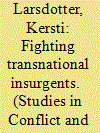

|
|
|
|
|
| Summary/Abstract |
Transnational insurgents are a common feature of contemporary wars, but research on how to address this problem is still scarce. This article examines the South African Defence Force's (SADF) counterinsurgency against Namibian transnational insurgents. It concludes that the South African forces focused a large amount of their efforts outside the borders of Namibia. Highly coercive operations in Angola and Zambia created the space for hearts and minds activities in Namibia, as well as forcing neighboring states to end their support for the insurgents. Although the war in Namibia is somewhat different from contemporary wars, SADF's cross-border strategy gives us some important insights into the regional dynamics of civil wars.
|
|
|
|
|
|
|
|
|
|
|
|
|
|
|
|
| 10 |
ID:
135280


|
|
|
|
|
| Summary/Abstract |
Why do non-state armed groups forcibly recruit civilians? To address this question I develop a conceptual framework distinguishing voluntary, coerced and forced recruitment. I then compare the recruitment tactics employed by ‘Mai-Mai’ militias and the RCD-Goma rebel group in the Democratic Republic of Congo (DRC) in order to inductively develop a theory explaining why groups with different initial economic and social endowments resort to force. This comparison draws on interviews with 41 former militia members and 11 former members of RCD-Goma. The theory suggests that forced recruitment is most likely to occur when non-state armed groups experience manpower deficits and when accountability (to local communities, government sponsors and/or the international community) is low. High levels of popular support will not necessarily prevent recourse to force under these conditions, but may mean that force is less necessary because voluntary and coerced recruits come forward to fill manpower gaps.
|
|
|
|
|
|
|
|
|
|
|
|
|
|
|
|
| 11 |
ID:
135553


|
|
|
|
|
| Summary/Abstract |
While ongoing peace talks may finally put an end to Colombia’s guerrilla fighting, it remains to be seen what will happen to Buenaventura, the urban monster the war created.
|
|
|
|
|
|
|
|
|
|
|
|
|
|
|
|
| 12 |
ID:
134983
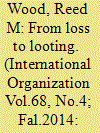

|
|
|
|
|
| Summary/Abstract |
Research into the causes of civilian abuse during civil conflict has increased significantly in recent years, yet the mechanisms responsible for changes in actors' tactics remain poorly understood. I investigate how the outcomes of discrete conflict interactions influence subsequent patterns of rebel violence against civilians. Two competing logics suggest opposite influences of material loss on violence. A stylized model of rebel-civilian bargaining illustrates how acute resource demands resulting from recent severe conflict losses may incentivize insurgent violence and predation. I also identify several factors that might condition this relationship. I evaluate hypotheses based on these expectations by first analyzing the behaviors of the Lord's Resistance Army using subnational conflict data and then analyzing a cross-sectional sample of post–Cold War African insurgencies. Results from both the micro- and macrolevel analyses suggest that rising battlefield costs incentivize attacks on civilians in the period immediately following the accrual of losses. However, group-level factors such as effective control over territory and the sources of rebel financing condition this relationship. The findings suggest potential benefits from examining the interaction of strategic conditions and more static organizational characteristics in explaining temporal and geographic variation in rebel violence.
|
|
|
|
|
|
|
|
|
|
|
|
|
|
|
|
| 13 |
ID:
135749


|
|
|
|
|
| Summary/Abstract |
Chile’s authorities have struggled to contain regular protests and attacks by the Mapuche minority and anarchist groups. Gideon Long examines the history of the community’s conflict over land rights, and the resulting legal and security issues.
|
|
|
|
|
|
|
|
|
|
|
|
|
|
|
|
| 14 |
ID:
136874


|
|
|
|
|
| Summary/Abstract |
India sat on the Security Council in 2011 when Resolution 1973 passed. This authorized NATO's intervention in the humanitarian crisis in Libya, which ultimately precipitated regime change. India's engagement with the crisis is analysed here with reference to various ‘identity-discourses’, treated as ‘shapers’ of India's specific policy-responses to the Libya crisis. This study finds that India flirted with the responsibility to protect (R2P) norm by abstaining when the Council voted on Resolution 1973; New Delhi effectively declined to oppose measures to resolve the crisis which were broadly consistent with Pillar III of R2P (that is, the responsibility of the international community to protect threatened persons). But after reflecting on NATO's intervention, Indian leaders largely retreated to their traditional preference for relatively strong interpretations of the sovereignty norm, suggesting India's flirtation with R2P – or at least with Pillar III – was brief and unhappy. While this paper finds that ‘soft’ liberal-democratic logic is very firmly established – Indian elites are committed to liberal-democratic principles, at least at home – it seems likely to take some time before the ‘hard’ liberal-democratic logic which shapes Pillar III-consistent responses to humanitarian crises becomes influential in Indian policy-making circles. In other words, New Delhi is unlikely to become a wholehearted supporter of the R2P norm without profound changes to India's international identity, which in turn has negative implications for the wider effort to further entrench R2P, especially its controversial Pillar III.
|
|
|
|
|
|
|
|
|
|
|
|
|
|
|
|
| 15 |
ID:
135458
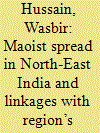

|
|
|
|
|
| Summary/Abstract |
The North-Eastern region of India has been riddled with insurgency for decades. All the States in the region have witnessed some sort of insurgent activities. However, negotiated settlements and ceasefire
agreements between the insurgent outfits and the government have been able to curb the levels of insurgent violence over the years. After decades of insurgency, there is some semblance of peace in the region. But, this peace, by no means, looks permanent. With most of the major insurgent groups in the region coming overground, the void created is being quickly filled up by small, newly sprung outfits. Most of these outfits are anti-talk factions of other insurgent groups, who have formed a separate entity, opposing the peace mode adopted by the parent outfit. However, the group which is taking maximum advantage of this void is the Maoists, nicknamed the ‘Red Rebels.’
|
|
|
|
|
|
|
|
|
|
|
|
|
|
|
|
| 16 |
ID:
134653


|
|
|
|
|
| Summary/Abstract |
Western states—the U.S. and many European states—have since the early 1990s conducted military operations at a pace that overshadows the number of military operations during the threat-penetrated Cold War era. During the last twenty years, Western states have switched their military outlook from containment and deterrence toward active engagement and expeditionary warfare. It is argued that even though in many cases the objectives of military activism are good and noble, the unintended—and in many cases the unrecognized—consequences of such action will in the long run be negative at best—and potentially even dangerous.
|
|
|
|
|
|
|
|
|
|
|
|
|
|
|
|
| 17 |
ID:
134960


|
|
|
|
|
| Summary/Abstract |
The end of the civil war in 2009 heralded hope that a new era of peace and inter-ethnic cooperation might be possible in post-war Sri Lanka. This hope now seems, at best, mere wishful thinking, as this article highlights an emerging conflict between the Sinhalese Buddhist majority and Sri Lankan Muslims. Through detailed analysis of online social data, argued evidence is provided that Muslim Sri Lankans are now at the receiving end of Islamaphobic rhetoric, even violence, from Sinhala Buddhist nationalist organisations, driven by a belief that the Muslim community represent a threat to Buddhism. The article suggests that Sinhala nationalists have skilfully adopted new internet technologies which have proved effective in their anti-Muslim campaigns. It becomes necessary to conclude that these attacks on Muslim minorities are an extension of pre-existing oppression patterns faced by other minorities residing on the island, particularly Tamils. Indeed, the rhetoric behind these attacks bears a striking resemblance to the type of nationalist discourse found during the Sri Lankan civil war
|
|
|
|
|
|
|
|
|
|
|
|
|
|
|
|
| 18 |
ID:
137066


|
|
|
|
|
| Summary/Abstract |
Civil conflicts constitute one of the most significant threats to human security. Understanding when belligerents are willing to undertake conflict management efforts is an important first step in better understanding how civil conflicts can be dealt with by the international community. In this article, I examine the occurrence of mediation in low-intensity conflicts. Drawing on insights from the war termination literature, I develop a theoretical argument that links mediation in low-intensity conflicts to the evolution of fighting. I argue that, while the characteristics of a conflict and its belligerents influence when mediation happens, how events unfold on the battlefield also influences the occurrence of mediation. I test this argument by looking at low-intensity conflicts in Africa from 1997 to 2004 using data on mediation in low-intensity conflicts and battle-level civil conflict events. The analysis highlights the important effect of battlefield outcomes and locations upon the occurrence of mediation in low-intensity conflicts.
|
|
|
|
|
|
|
|
|
|
|
|
|
|
|
|
| 19 |
ID:
136091


|
|
|
|
|
| Summary/Abstract |
This article develops a conceptual framework to explain that a rebel group, in war-to-peace transition, is likely to use violence in contested areas in order to reclaim its control over territory and populations. The decision to use violence, however, depends on whether post-accord elections are held prior to the demobilization of rebel combatants. Use of violence would still be a preferred strategy for a rebel group should the participation in elections fail to produce the expected outcome. Violence influences post-conflict elections, and when the use of violence determines an electoral outcome, parties involved in the peace process may find it difficult to reconcile their differences on peace agreement implementation. District-level data from Nepal are used to test the arguments, and the effect of post-accord violence on peace processes is evaluated in a comparative perspective.
|
|
|
|
|
|
|
|
|
|
|
|
|
|
|
|
| 20 |
ID:
135009


|
|
|
|
|
| Summary/Abstract |
The willingness to take risks made Rear Admiral David Glasgow Farragut, victor at New Orleans in 1862 and Mobile Bay in 1864, the Union’s leading naval commander in the Civil War. Farragut’s boldness contrasted strongly with the lack of decisiveness shown in the failure in April 1863 to seize the port of Charleston, South Carolina, by Rear Admiral Samuel Francis Du Pont, whose capture of Port Royal Sound in South Carolina in November of 1861 had made him the North’s first naval hero of the war. Du Pont’s indecisiveness at Charleston led to his removal from command and a blighted career, while the risk-taking Farragut went on to become, along with generals U.S. Grant and William T. Sherman, one of the principal architects of Union victory.
|
|
|
|
|
|
|
|
|
|
|
|
|
|
|
|
|
|
|
|
|